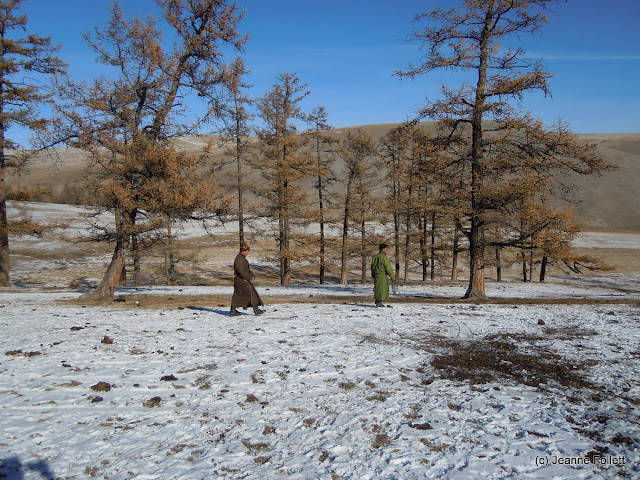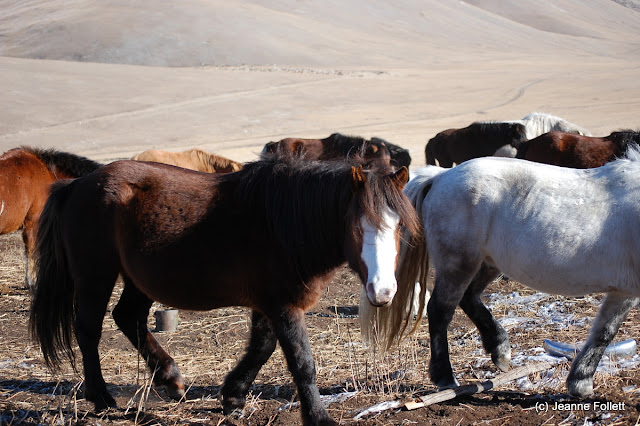It seems
like hours since Chimdee went into the nomad’s ger to ask permission
for us to visit, but it’s probably only a couple minutes. Finally, he comes outside and gestures to
us.
 |
| Two solar panels and a satellite TV antenna! Note the flap at the top that can be opened to allow for air and light, and also for stovepipe pentration. |
There are
two motorbikes parked outside the ger.
A rifle leans against one and as I approach, something familiar on the
rifle catches my eye. On the eye end of
the scope is the label for Coke Zero soda, taped in place with another piece of
plastic. Apparently, they were
installed to extend the scope.
“They make
use of everything,” says Yusef.
 |
| Note the scope on the rifle. |
 |
| It appears to be extended with two plastic soda bottles. |
He picks up
the rifle and says it’s probably homemade, pointing to part of the wooden stock.
We enter the
ger and I’m in awe. It looks a lot like
the ger I’m staying in at Ashihai, except there’s no electric in-floor radiant
heat here. This floor is covered with
carpets and a wood/coal/dung burning stove provides a pleasant warmth.
 |
| The crown |
 |
| A small TV and the satellite receiver. Hard to get a crisp photo in the ger because of the light and i did not want to use the flash too much. |
 |
| The battery charged by the solar panels sits on the floor. |
 |
| The colorful cabinets surprised me. Those are children's toys on the floor behind the herder. The decorative bands at the top of the walls contain Shamanist symbols. |
Yusef and I
sit on one of two beds/day beds. I am
surprised at the amount of furniture here.
Brightly painted cabinets are across one wall and a simple cabinet with
shelves serves at the kitchen. How on
earth do they pick up and move a couple times a year with all the
cabinets? Do they use horses to carry the gear?
 |
| The kitchen. Note the white bucket at right on the floor. Raw meat is in the bowl sitting atop the bucket. |
There is no
stove as all cooking is done on the center heater.
There
appears to be a minimal amount of cookware, though there might be some in a
cabinet. There’s a bowl on the floor
that holds raw meat—probably tonight’s dinner.
Other than that, I see no foodstuffs.
The diet of nomads relies heavily on milk, meat, and fats, with the fats
helping the herders tolerate the cold climate.
Vegetable are seldom available, and flour and rice must be purchased.
Near the
door are a chainsaw, a milk jug, and other items necessary for their life.
 |
| A tire pump, probably for the motorbikes. |
 |
| Chain saw, milk jug, and small broom. Firewood is in the square container. |
Two men are
seated on the floor by the heater. A
young girl stands between them and she stares at me the entire time I am
there. I might be the first
white-skinned, blue-eyed person she has ever seen.
 |
| Lhagvadorj at left and his brother Batdorj at right. I do not know the girl's name. Resorted to the flash because non-flash photos were fuzzy. |
 |
| She never took her eyes off me. |
The men are
drinking salted milk tea and eating things that look like white laundry
detergent cakes. A plate of them is
passed and I take the tiniest, thinnest piece I can find. They are called aaruul and is made by allowing milk to curdle, then straining the
curds from the whey and drying it in chunks.
It is packed with nutrients, given credit for the strong and healthy
teeth of Mongols, and a handy trail snack.
 |
| Most of the aaruul was in larger cakes. I took the smallest, thinnest piece. |
It’s like
chewing on sheet rock, not that I’ve ever chewed on sheet rock, eith a slightly astringent flavor.
I am
also served a bowl of tea, and it turns out to be salted yak milk tea. It is hot and rich, and I cannot taste salt
at all. Initially, I think the salt
makes the tea taste so rich. Not until
later does it dawn on me that the milk is raw, full-cream, and unpasteurized.
It’s a good
thing that there is a language barrier between me and these nomads because I
would have broken every bit of etiquette.
I would have asked the woman’s name—that is not done. I would have asked which of the men is
married to her and the father of the child—horrendous faux pas. I’m sure there
are many other potential traps for me to fall into.
Yusef tells
me the men are Darkhad, closely related to the Dukha (reindeer people) and Tuva
peoples that are indigenous to this area.
The men are brothers—Lhagvadorj and Batdorj. This will be their winter home as they are
protected from the wind and there is plenty of firewood available.
The brothers
finish their tea and aaruul, and roll cigarettes.
The woman
untangles a rope halter and hands it to her husband, who goes outside with his
brother. I notice one of the men has
fashioned sheep hide gauntlets for the handles of his motor bike and I stick my hand in one and mime how nice and warm it is.
They smile and nod.
 |
| Note the hide gauntlets. |
Yusef and I
wander around the area, looking at the sheds where the sheep and goats are
herded to at night to keep them safe from predators, then we reach the khoroo—the horse corral. One horse is tied outside the corral and it
moves away from me to the farthest extent of its rope and eyes me warily. I keep my distance, too.
 |
| Keeping an eye on the stranger. |
 |
| For the goats and sheep. |
 |
| A small hut of dried dung and logs. |
I’m taking
photos of the men selecting a couple horses and Yusef says the men asked if I
would take photos of them with their horses and send them to them. I get the good camera and take lots of
photos, all the while wondering how on earth I’m going to mail photos to these
men.
 |
| Yusef gave the men pre-rolled cigarettes. |
 |
| Thick hair and barefoot. |
Once the
horses they want are selected, they open the corral gates and all the horses
exit the corral, turn right and pass me, and proceed down a gully to the larch
forest. It’s mid-afternoon, and the horses disappear like ghosts in the low afternoon sun that shines like
gold through the yellow larch forest.
More photos from the nomad visit:
 |
| Location of the herder's home. |
 |
| Home, sweet ger. |
 |
| Chimdee and the rifle. |
 |
| Warm deel (robes). |
 |
| Lots of firewood. |
 |
| Yusef the clown. I was going to write "Yusef the ham" (meaning showoff) but he's Muslim so I didn't. |
















































You've presented an intimate peek into these Mongolian herders' lives.
ReplyDeleteDid you ask Yusef how these herders will move their ger to the next destination?
I'd also like to know how you will get the photos you took of them to them.
I remain confused about when in our trip you took these photos. As I did in the post above this post my guess would be during your three day tour at the beginning of our visit (the first weekend when you set out on Friday morning). But I am not willing to rule out the day you took off sans Patti and myself up at the lake in the North. Because of the horses I lean to the first weekend tour when you were in a National Park (did it begin with the letter H?) that more or less featured many horses. Cap and Patti in Goa.
ReplyDeleteI got my answer by continuing to read down your posts. Yes indeed it was the day in the North at the lake when Patti and I opted to say put in camp and let you go to the waterfall. The little girl sure looks wary as she eyes-you doesn't she. Great post. Cap and Patti ..
DeleteYes, in the north on the aborted trip to the waterfall. These were Mongolian horses. The trip to Terelj featured Mongolian horses, also. The trip to Hustai Nat'l. Park was all about Takhi--the indigenous wild horses that have never been domesticated.
DeleteThanks for the reply. Smiles. Cap
Delete